2008 MERCEDES-BENZ A-CLASS HATCHBACK towing
[x] Cancel search: towingPage 120 of 305
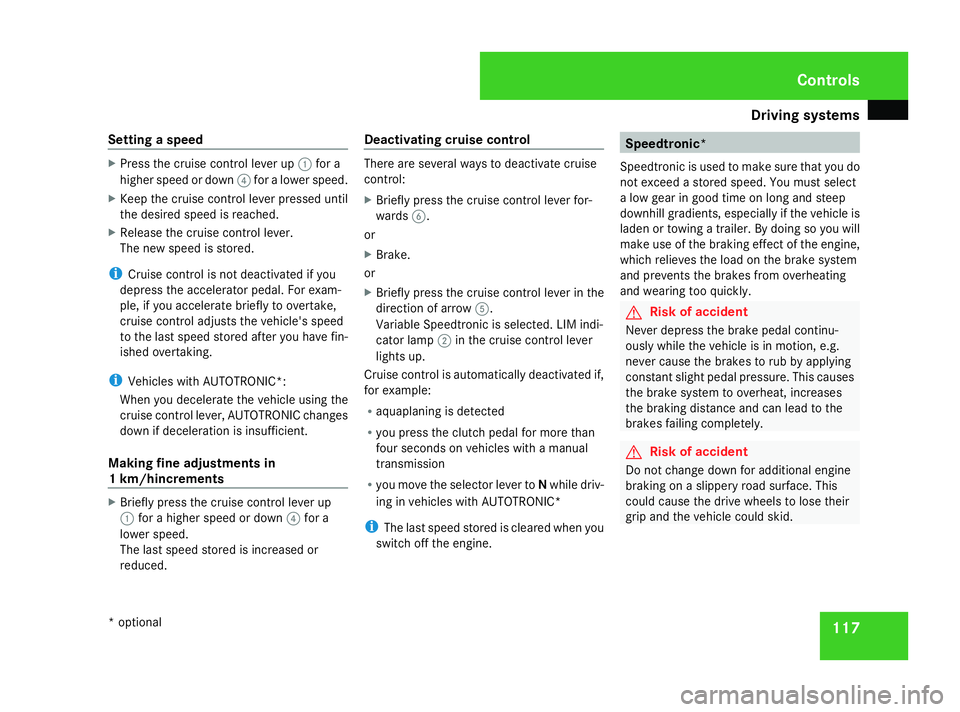
Driving sys
tems 117
Setting a speed X
Press the cruise control lever up 1for a
higher speed or down 4for a lower speed.
X Keep the cruise control lever pressed until
the desired speed is reached.
X Release the cruise control lever.
The new speed is stored.
i Cruise control is not deactivated if you
depress the accelerator pedal. For exam-
ple, if you accelerate briefly to overtake,
cruise control adjusts the vehicle's speed
to the last speed stored after you have fin-
ished overtaking.
i Vehicles with AUTOTRONIC*:
When you decelerate the vehicle using the
cruise control lever, AUTOTRONIC changes
down if deceleration is insufficient.
Making fine adjustments in
1 km/hincrements X
Briefly press the cruise control lever up
1 for a higher speed or down 4for a
lower speed.
The last speed stored is increased or
reduced. Deactivating cruise control There are several ways to deactivate cruise
control:
X Briefly press the cruise control lever for-
wards 6.
or
X Brake.
or
X Briefly press the cruise control lever in the
direction of arrow 5.
Variable Speedtronic is selected. LIM indi-
cator lamp 2in the cruise control lever
lights up.
Cruise control is automatically deactivated if,
for example:
R aquaplaning is detected
R you press the clutch pedal for more than
four seconds on vehicles with a manual
transmission
R you move the selector lever to Nwhile driv-
ing in vehicles with AUTOTRONIC*
i The last speed stored is cleared when you
switch off the engine. Speedtronic*
Speedtronic is used to make sure that you do
not exceed a stored speed. You must select
a low gear in good time on long and steep
downhill gradients, especially if the vehicle is
laden or towing a trailer. By doing so you will
make use of the braking effect of the engine,
which relieves the load on the brake system
and prevents the brakes from overheating
and wearing too quickly. G
Risk of accident
Never depress the brake pedal continu-
ously while the vehicle is in motion, e.g.
never cause the brakes to rub by applying
constant slight pedal pressure. This causes
the brake system to overheat, increases
the braking distance and can lead to the
brakes failing completely. G
Risk of accident
Do not change down for additional engine
braking on a slippery road surface. This
could cause the drive wheels to lose their
grip and the vehicle could skid. Controls
* optional
169_AKB; 2; 4, en-GB
wdomann,
Version: 2.10.6 2008-07-16T08:52:06+02:00 - Seite 117 ZDateiname: 6515_0315_02_buchblock.pdf; preflight
Page 126 of 305

Driving sys
tems 123
i
Parktronic is automatically activated
when you turn the key to position 2in the
ignition lock.
Trailer towing* Parktronic is deactivated for the rear area
when you establish an electrical connection
between your vehicle and a trailer.
!
Remove the detachable trailer coupling if
it is no longer required. Parktronic meas-
ures the minimum detection range to an
obstacle from the bumper, not the ball cou-
pling. Active parking assist*
Active parking assist is an electronic parking
aid with ultrasound. Ultrasound is used to
measure the road on both sides of the vehicle.
A suitable parking space is indicated by the
parking symbol. Active steering intervention
can assist you during parking. You may also
use Parktronic (Y page 120). When Parktronic
is deactivated, active parking assist is also
unavailable. G
Risk of accident
Active parking assist is merely an aid and
may sometimes recommend parking
spaces that are not suitable for parking.
These might be, for example, spaces where
parking is prohibited, driveways, unsuitable
surfaces, etc.
Active parking assist measures the parking
space as you drive past it. Any later
changes to the parking space are not taken
into account. This may be the case, for
instance, when the vehicle parked in front
of or behind the space changes its position
or when an obstacle is moved into the park-
ing space.
Active parking assist does not relieve you
of the responsibility of paying attention. If
you rely solely on Active parking assist, you
could cause an accident and injure yourself
and others.
You are always responsible for safety and
must continue to pay attention to your
immediate surroundings when parking and
manoeuvring. G
Risk of accident
Objects located above the height range of
Active parking assist will not be detected when the parking space is measured. These
are not taken into account when the park-
ing procedure is calculated, e. g. overhang-
ing loads, tail sections or loading ramps of
goods vehicles. In some circumstances,
Active parking assist may therefore guide
you into the parking space too early. This
may lead to a collision. For this reason, you
should avoid using Active parking assist in
such situations.
G
Risk of accident
The front of the vehicle will veer out in the
direction of the oncoming traffic during the
parking operation. In some cases the vehi-
cle will also take you onto sections of the
oncoming lane during the parking proce-
dure.
You are responsible for safety at all times
and must pay attention to any road users
approaching or passing. Stop the vehicle if
necessary or cancel the Active parking
assist parking procedure. G
Risk of injury
Make sure that no persons or animals are
in the manoeuvring range. Otherwise, they
could be injured. Controls
* optional
169_AKB; 2; 4, en-GB
wdomann,
Version: 2.10.6 2008-07-16T08:52:06+02:00 - Seite 123 ZDateiname: 6515_0315_02_buchblock.pdf; preflight
Page 130 of 305

Driving sys
tems 127
A warning tone sounds. the multi-function
display shows the message:
Park Assist
cancelled.
When active parking assist is cancelled, you
must steer again yourself.
Trailer towing* For vehicles with a trailer coupling, the mini-
mum length for parking spaces is slightly
increased.
If you have attached a trailer to your vehicle,
you should not use active parking assist.
Once the electrical connection is established
between your vehicle and the trailer, active
parking assist is no longer available. Park-
tronic is deactivated for the rear area. ECO start/stop function*
The ECO start/stop function automatically
switches off the engine as soon as you stop
the vehicle and restarts the engine as soon as
you prepare to pull away again. Each time the
engine is started using the key, the ECO
start/stop function is activated.
Conditions for the automatic engine
switch-off The ECO start/stop function automatically
switches off the engine if all of the following
conditions are met:
R you have shifted to neutral
R the clutch pedal is not depressed
R the brake pedal is depressed
R the vehicle speed is very low
R the engine has reached its operating tem-
perature
R the indicator lamp in the ECO button is lit
green
R the bonnet is closed
R the outside temperature is within the com-
fort range R
the battery is sufficiently charged
R the brake vacuum is stable
Conditions for the automatic engine
start The ECO start/stop function automatically
switches on the engine if one of the following
conditions is met:
R
the brake pedal is released
R the clutch pedal is depressed
R the vehicle speed exceeds a certain thresh-
old
R the ECO button is pressed
R the brake vacuum has decreased
R the battery charge has dropped
R the demister function of Thermotronic *is
selected Controls
* optional
169_AKB; 2; 4, en-GB
wdomann,
Version: 2.10.6 2008-07-16T08:52:06+02:00 - Seite 127 ZDateiname: 6515_0315_02_buchblock.pdf; preflight
Page 147 of 305
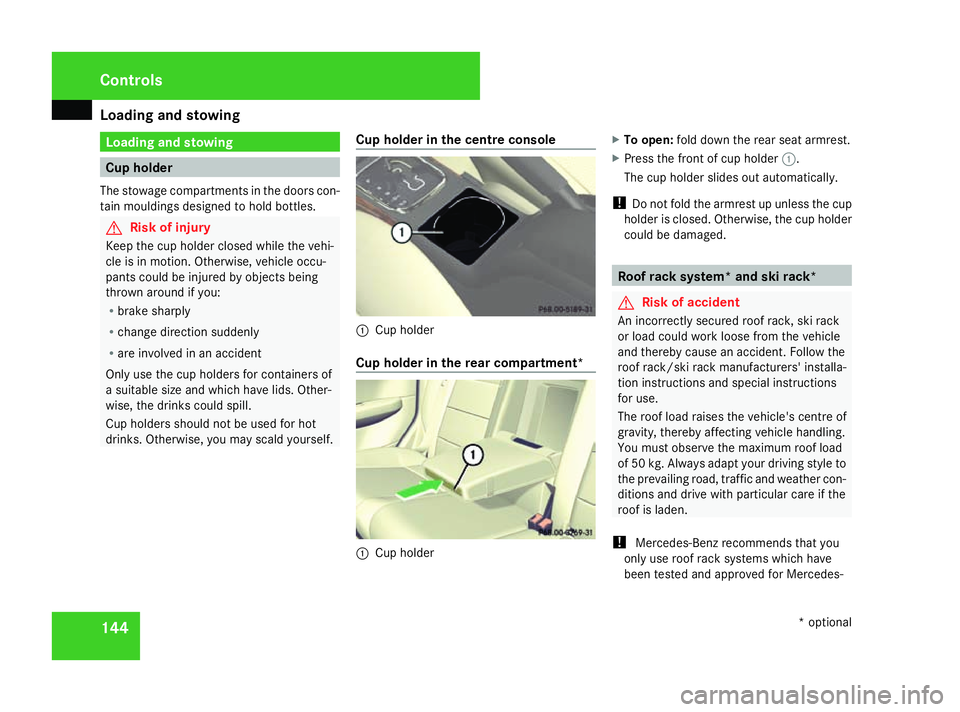
Loading and stowing
144 Loading and stowing
Cup holder
The stowage compartments in the doors con-
tain mouldings designed to hold bottles. G
Risk of injury
Keep the cup holder closed while the vehi-
cle is in motion. Otherwise, vehicle occu-
pants could be injured by objects being
thrown around if you:
R brake sharply
R change direction suddenly
R are involved in an accident
Only use the cup holders for containers of
a suitable size and which have lids. Other-
wise, the drinks could spill.
Cup holders should not be used for hot
drinks. Otherwise, you may scald yourself. Cup holder in the centre console 1
Cup holder
Cup holder in the rear compartment* 1
Cup holder X
To open: fold down the rear seat armrest.
X Press the front of cup holder 1.
The cup holder slides out automatically.
! Do not fold the armrest up unless the cup
holder is closed. Otherwise, the cup holder
could be damaged. Roof rack system* and ski rack*
G
Risk of accident
An incorrectly secured roof rack, ski rack
or load could work loose from the vehicle
and thereby cause an accident. Follow the
roof rack/ski rack manufacturers' installa-
tion instructions and special instructions
for use.
The roof load raises the vehicle's centre of
gravity, thereby affecting vehicle handling.
You must observe the maximum roof load
of 50 kg. Always adapt your driving style to
the prevailing road, traffic and weather con-
ditions and drive with particular care if the
roof is laden.
! Mercedes-Benz recommends that you
only use roof rack systems which have
been tested and approved for Mercedes- Controls
* optional
169_AKB; 2; 4, en-GB
wdomann,
Version: 2.10.6
2008-07-16T08:52:06+02:00 - Seite 144 Dateiname: 6515_0315_02_buchblock.pdf; preflight
Page 148 of 305
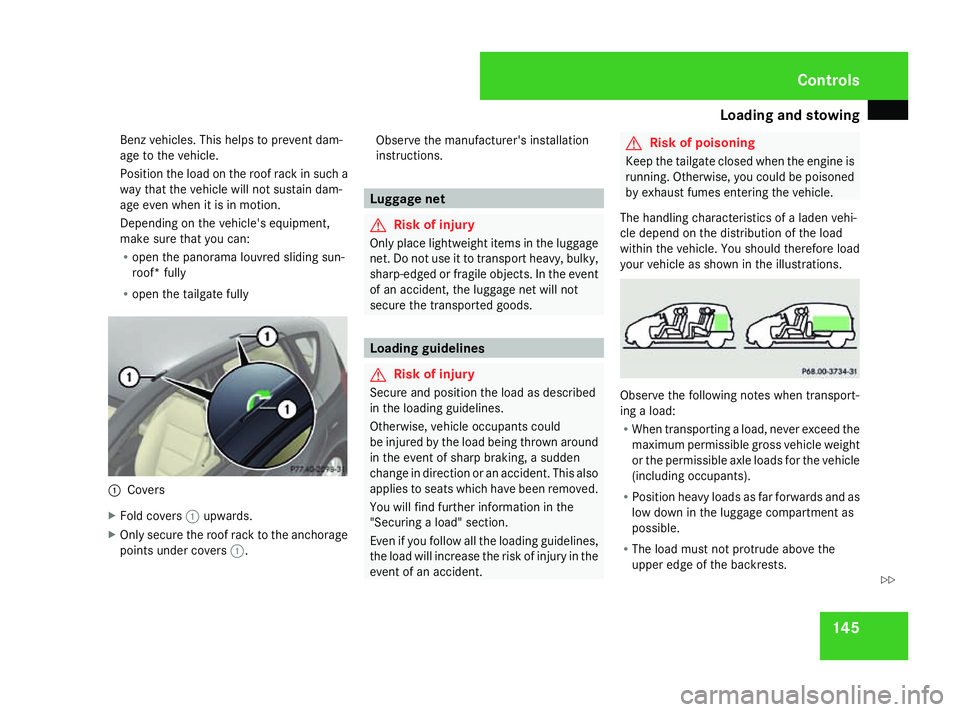
Loading and stowing
145
Benz vehicles. This helps to prevent dam-
age to the vehicle.
Position the load on the roof rack in such a
way that the vehicle will not sustain dam-
age even when it is in motion.
Depending on the vehicle's equipment,
make sure that you can:
R open the panorama louvred sliding sun-
roof* fully
R open the tailgate fully 1
Covers
X Fold covers 1upwards.
X Only secure the roof rack to the anchorage
points under covers 1. Observe the manufacturer's installation
instructions. Luggage net
G
Risk of injury
Only place lightweight items in the luggage
net. Do not use it to transport heavy, bulky,
sharp-edged or fragile objects. In the event
of an accident, the luggage net will not
secure the transported goods. Loading guidelines
G
Risk of injury
Secure and position the load as described
in the loading guidelines.
Otherwise, vehicle occupants could
be injured by the load being thrown around
in the event of sharp braking, a sudden
change in direction or an accident. This also
applies to seats which have been removed.
You will find further information in the
"Securing a load" section.
Even if you follow all the loading guidelines,
the load will increase the risk of injury in the
event of an accident. G
Risk of poisoning
Keep the tailgate closed when the engine is
running. Otherwise, you could be poisoned
by exhaust fumes entering the vehicle.
The handling characteristics of a laden vehi-
cle depend on the distribution of the load
within the vehicle. You should therefore load
your vehicle as shown in the illustrations. Observe the following notes when transport-
ing a load:
R
When transporting a load, never exceed the
maximum permissible gross vehicle weight
or the permissible axle loads for the vehicle
(including occupants).
R Position heavy loads as far forwards and as
low down in the luggage compartment as
possible.
R The load must not protrude above the
upper edge of the backrests. Controls
169_AKB; 2; 4, en-GB
wdomann
, Version: 2.10.6
2008-07-16T08:52:06+02:00 - Seite 145 ZDateiname: 6515_0315_02_buchblock.pdf; preflight
Page 149 of 305
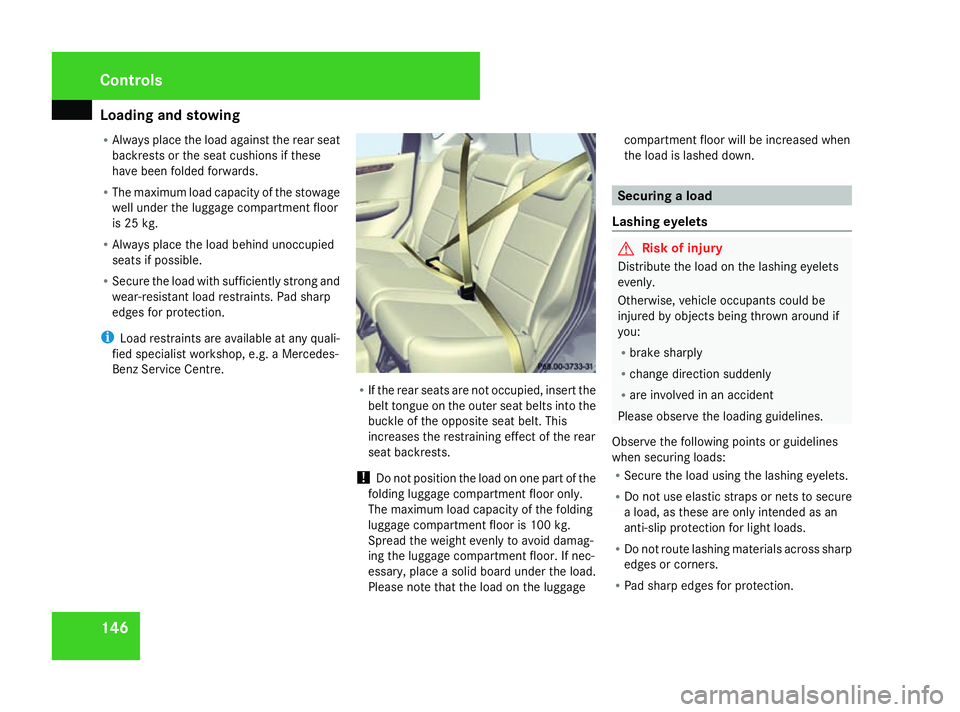
Loading and stowing
146
R
Always place the load against the rear seat
backrests or the seat cushions if these
have been folded forwards.
R The maximum load capacity of the stowage
well under the luggage compartment floor
is 25 kg.
R Always place the load behind unoccupied
seats if possible.
R Secure the load with sufficiently strong and
wear-resistant load restraints. Pad sharp
edges for protection.
i Load restraints are available at any quali-
fied specialist workshop, e.g. a Mercedes-
Benz Service Centre. R
If the rear seats are not occupied, insert the
belt tongue on the outer seat belts into the
buckle of the opposite seat belt. This
increases the restraining effect of the rear
seat backrests.
! Do not position the load on one part of the
folding luggage compartment floor only.
The maximum load capacity of the folding
luggage compartment floor is 100 kg.
Spread the weight evenly to avoid damag-
ing the luggage compartment floor. If nec-
essary, place a solid board under the load.
Please note that the load on the luggage compartment floor will be increased when
the load is lashed down. Securing a load
Lashing eyelets G
Risk of injury
Distribute the load on the lashing eyelets
evenly.
Otherwise, vehicle occupants could be
injured by objects being thrown around if
you:
R brake sharply
R change direction suddenly
R are involved in an accident
Please observe the loading guidelines.
Observe the following points or guidelines
when securing loads:
R Secure the load using the lashing eyelets.
R Do not use elastic straps or nets to secure
a load, as these are only intended as an
anti-slip protection for light loads.
R Do not route lashing materials across sharp
edges or corners.
R Pad sharp edges for protection. Controls
169_AKB; 2; 4, en-GB
wdomann,
Version: 2.10.6 2008-07-16T08:52:06+02:00 - Seite 146Dateiname: 6515_0315_02_buchblock.pdf; preflight
Page 150 of 305

Loading and stowing
147
Securing loads in the luggage compart-
ment
There are four lashing eyelets in the luggage
compartment. Example: 5-door vehicle
1
Lashing eyelets
X Secure the load using lashing eyelets 1or
the mounting cups for the seats, if the seats
have been removed. Securing a load when the seats have been
removed Rear seat removed
X
Guide the load restraints in a cross pattern
over the load, as shown in the illustration.
X Secure the load using the lashing eyelets
or the mounting cups on the seats. G
Risk of injury
Always stow the load so that it does not
interfere with driving the vehicle.
Avoid obstructing the driver's line-of-sight.
The load must not protrude above the upper
edge of the door trim if the front-passenger
seat has been removed.
Pad sharp edges for protection. This will
reduce the risk of lacerations and prevent
the load restraints from wearing.
Observe the following notes: R
The load must not protrude above the
upper edge of the door trim.
R Long loads must only be placed low down
and towards the front of the front-
passenger footwell.
! Load restraints must not be fastened to
the front right-hand mounting cup. Other-
wise, the contact switch for the front-
passenger seat could be damaged.
Securing a light load using a retaining
net*
X Place the retaining net over the load.
X Engage the retaining net hooks in the lash-
ing eyelets. Through-loading feature*
G
Risk of injury
Do not transport unsecured objects in the
through-loading facility.
Otherwise, you and other vehicle occu-
pants could be injured by objects being
thrown around the vehicle in the event of
sharp braking, a sudden change in direction
or an accident. Controls
* optional
169_AKB; 2; 4, en-GB
wdomann , Version: 2.10.6 2008-07-16T08:52:06+02:00 - Seite 147 ZDateiname: 6515_0315_02_buchblock.pdf; preflight
Page 151 of 305
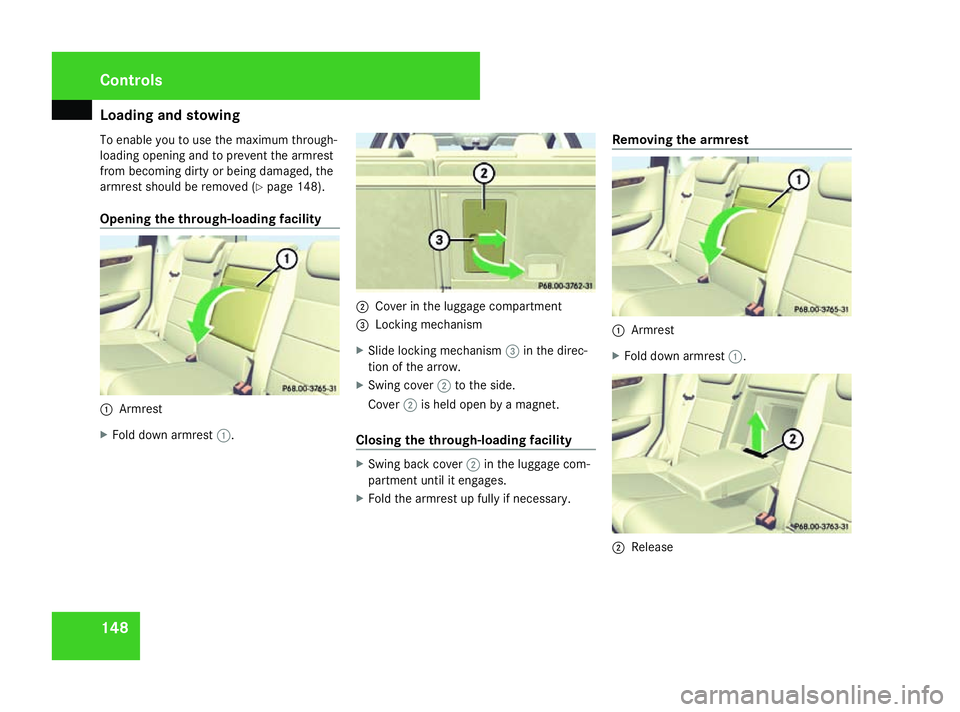
Loading and stowing
148
To enable you to use the maximum through-
loading opening and to prevent the armrest
from becoming dirty or being damaged, the
armrest should be removed (Y page 148).
Opening the through-loading facility 1
Armrest
X Fold down armrest 1. 2
Cover in the luggage compartment
3 Locking mechanism
X Slide locking mechanism 3in the direc-
tion of the arrow.
X Swing cover 2to the side.
Cover 2is held open by a magnet.
Closing the through-loading facility X
Swing back cover 2in the luggage com-
partment until it engages.
X Fold the armrest up fully if necessary. Removing the armrest 1
Armrest
X Fold down armrest 1. 2
Release Controls
169_AKB; 2; 4, en-GB
wdomann,
Version: 2.10.6 2008-07-16T08:52:06+02:00 - Seite 148Dateiname: 6515_0315_02_buchblock.pdf; preflight